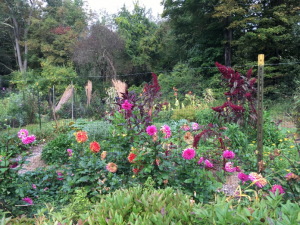Updates
Leslie’s friends and frequent users of this Blog might like to know of the following developments concerning the archiving of Leslie’s written work and of her gardens.
THE COLLECTED PAPERS OF LESLIE LAND
Leslie’s papers are being preserved at The Schlesinger Library, Radcliffe Institute for Advanced Study, Harvard University. https://www.radcliffe.harvard.edu/schlesinger-library The Schlesinger houses the collections Culinary Historians as well as of noted American Women. Here Leslie will take her place alongside Julia Child, Betty Freidan and others. From their records, it appears to me that the Library became interested in obtaining Leslie’s papers as far back as 1985.
In today’s age the term “papers” designates far more than what we assumed in times past. As many writers of her age, Leslie’s words and ideas were recorded by an increasingly complex array of modalities from handwritten entries on scraps of paper, in notebooks and journals, typewritten script, through iteration upon iteration of word-processing machines and digitally processed computer files with differing formats and storage systems, to various email, audio video, social media and associated interfacing programs. Even the website you have accessed here and on which you are reading these words has been ‘captured’ by the Library.
Being an inveterate collector, record keeper and historian, as you might imagine, Leslie saved everything.
Over the past six years, from our two houses, two barns and two sheds, I have been prying these documents from the shelfs, closets, drawers and desks, annotating what I could when I thought it appropriate, and sending the collection off to the Schlesinger. Technologically savvy Librarians from area Colleges helped in condensing the digital records from various computers and hard drives. To date, 27 boxes have been sent off. The annotated inventory record itself runs to 37 pages. For me, it was a help to have previously worked as a research assistant at The University of Chicago Law School Library when it came to making decisions as to what might be worth saving or annotating.
Additional material may be added as it becomes available. If you have personal correspondence with Leslie or other material which you would like to add please contact Kathryn Allamong Jacob, Curator of Manuscripts at the Library.
At the Schlesinger, only a small part of the collected papers has as yet been digitized and catalogued. Those currently available can be found via their HOLIS Search at https://hollis.harvard.edu/primo-explore/search?query=any,contains,Leslie%20Land&tab=everything&search_scope=everything&vid=HVD2&lang=en_US&offset=0
LESLIE’S GARDENS
Leslie’s Gardens have been modified and maintained. In both the New York and Maine Gardens, the emphasis has moved from select plots of edibles tested for their hardiness and flavor to perennial plantings with more a sculptural aspect.
Maine, in particular, where excellent organic produce is readily available, has seen the most obvious changes. Following the trends and plans that Leslie initiated prior to her death, the dominant theme here has been to focus on perennials:

Celia and Ursula surrounded by perennial plantings in the Upper Garden
Everywhere there is more open space, the vistas are longer, more expansive, the view towards the water has opened up.

The Lower Perennial Garden, once vegetables, with vistas toward the St. Georges tidal river.
In New York the emphasis has been on flowers.

New York side garden with Eucomis, canna, and goldenrod set amongst perennial shrubs.
At times a Mother/Daughter team has run the main gardens here for their Herb and Flower Business. The soil continues to be amended annually via organic sustainable techniques and produces far beyond the expectations of first time users of this garden. Once a railroad bed, the soil is now double dug deep and of a rich loamy composition.

The main New York Garden, south plot. Once a Railroad, the soil is now deep dark and productive, overflowing with flowers.
The one area which I have yet to resolve is the disposition of Leslie’s private Library. Stretching over 100 linear feet, her collection of agricultural, culinary, and related references represent a highly curated selection which informed her work and life. I am loath to break it up thinking, as I do, that the integrity of the collection is worth more than the sum of its parts, but to date I have not found a home for this resource. I would welcome any suggestions you might have. This website will continue to be maintained.
On a related note, you might wish to know that Lois is doing well and continues to garner wide recognition for her painting. Other artists continue to come by to paint and play in the gardens, and Kristi continues on as my master gardener, knowing much more than I, and retaining a clear memory of what Leslie intended, reprimanding me when I deviate too far from those plans.
As for me, the gardens, the writings, the lives together remain as a clear message and living testament, even as I move on, to what I learned from Leslie: One’s life is One’s work. It is all there is, the sum and substance of our time here on earth. We plant the seeds, separate from the sprout the weeds which rob from the promise, cut away the disease which eats at the heart, where possible prune away the distracting, the disturbing, the untruthful. “Edit,” as she would say. What remains is the essence; the essence of the fruit, of the life – the sole purpose of which, once savored, is to be returned again to the soil as compost for the future. It is a cycle repeated as time itself repeats, for time reveals us all as compost; the green fuse, the fruit forced firm and full, the memories fermenting in the firmament.
Who tends this space?
The wind blows, the bough bends,
Ashes lie in the garden.
Without discrimination,
The summer’s sun pushes both
rose and rust to ruination.
Bill Bakaitis December 2019















Get a Trackback link